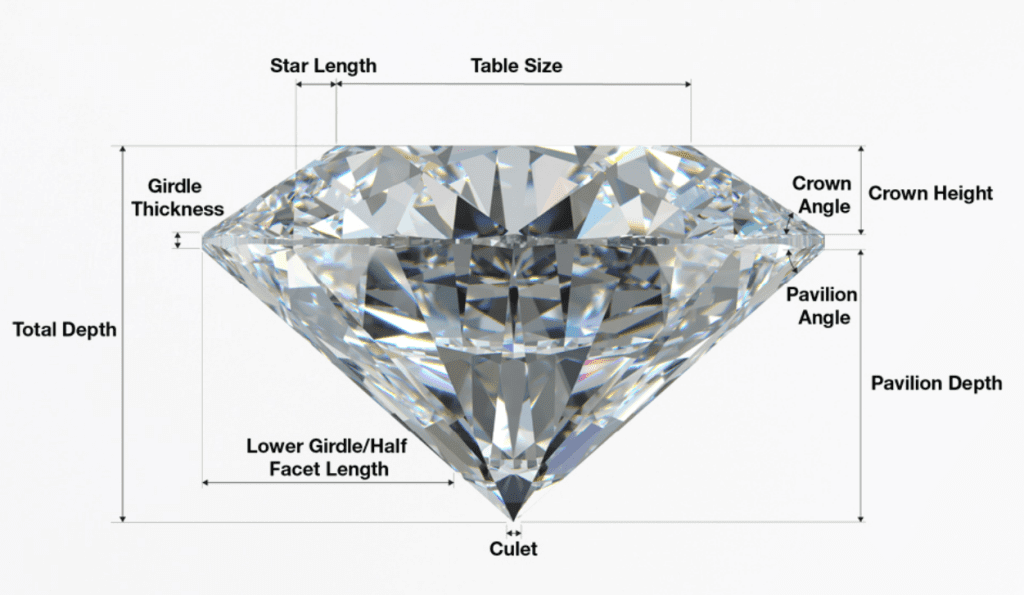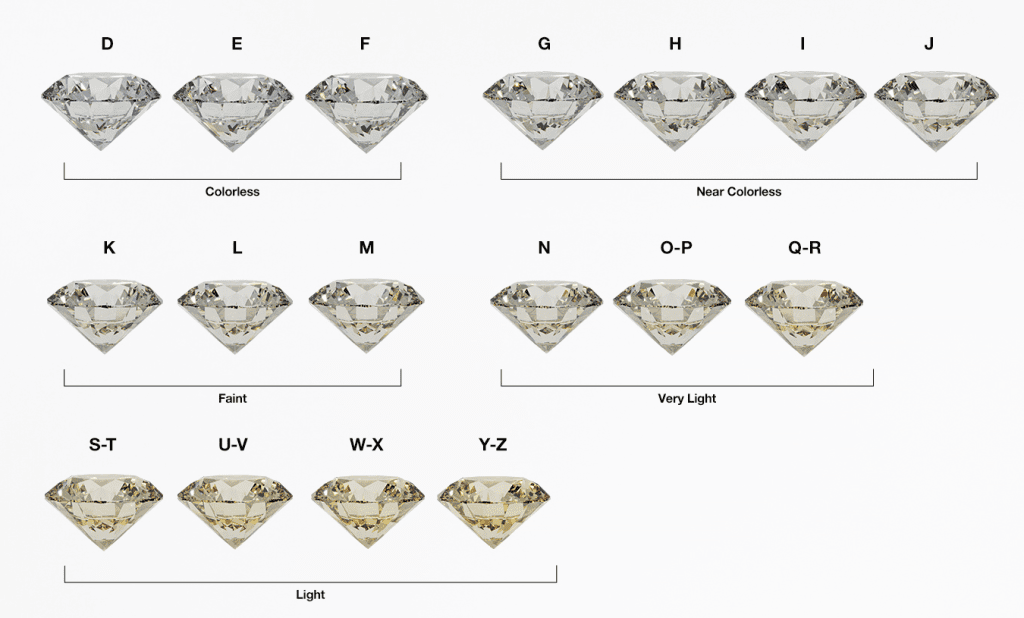Shopping for a diamond can feel overwhelming with so many sparkling stones to choose from. But how do you know which diamond is the right one? Enter the 4 Cs of diamonds —diamond cut, diamond color, diamond clarity, and diamond carat weight. These four factors are your guide to finding that perfect gem. The 4 Cs provide a universal standardized way to assess diamond quality and value whether you’re purchasing an engagement ring, a special gift, or adding to your diamond jewelry collection.
What Are the 4 Cs of Diamonds?
The 4 Cs aren’t just technical jargon; they’re your guide in buying a diamond. Think of them as a universal language for comparing diamonds objectively. Each “C” plays a vital role in a diamond’s overall beauty and value. Understanding how they interact helps you avoid confusion and costly mistakes when buying diamonds or even a simple wedding band.
The 4 Cs are essential characteristics used to determine a diamond’s quality:
- Cut: Refers to how well a diamond’s facets interact with light, creating brilliance and sparkle.
- Color: Measures the presence of color in a diamond, from colorless (D grade) to light yellow or brown (Z grade).
- Clarity: Assesses internal flaws (inclusions) and external blemishes visible under magnification.
- Carat Weight: Represents the weight of a diamond, influencing its size and perceived value.
Each C plays a pivotal role in the diamond’s beauty and price, making it essential to understand how they work together.
GIA provides more insights into the history and standardization of diamond grading.
Decoding the 4Cs of Diamonds
Cut: The Sparkle Factor
The cut is arguably the most important of the 4 Cs. This refers to how well a diamond’s facets interact with light. It’s not just about diamond shape (round, princess, emerald, etc.) but how well those angles, proportions, and polish work together to maximize light return. A well-cut diamond reflects light internally, creating brilliance and fire, and can even make smaller diamonds appear larger.
- What to Know: Cut grades range from Excellent to Poor. Always prioritize cut when choosing a diamond.
- Pro Tip: Avoid focusing solely on shape (e.g., round, princess, or emerald); instead, consider proportions and angles for optimal light performance.

Color: From Icy White to Subtly Warm
Most people picture diamonds as perfectly colorless. But diamonds come in various colors, ranging from colorless (rated D on the diamond color scale) to slightly tinted with yellow or brown (going down to Z). These color variations don’t necessarily diminish a diamond’s value. In fact, for some, warmer stones offer good value and unique character.
- What to Know: Near-colorless diamonds (grades G-H) often offer excellent value without noticeable color to the naked eye.
- Pro Tip: Consider the diamond’s setting. Warm-toned metals like gold complement diamonds with slight color, enhancing their appearance.

Clarity: A Look Inside
Almost all diamonds have tiny imperfections called inclusions (internal flaws) or blemishes (external flaws). The Gemological Institute of America (GIA) grades clarity on a clarity scale from Flawless (no inclusions visible under 10x magnification) to Included (inclusions visible to the naked eye). Often, these imperfections are microscopic and offer unique characteristics that distinguish a diamond.
- Clarity Grades: Ranges from Flawless (FL) to Included (I).
- Pro Tip: Choose a clarity grade like VS1 or VS2, where inclusions are invisible without magnification, ensuring beauty and value.

Carat Weight: Size Matters, but So Does Quality
Carat is a unit of weight used to measure diamonds (1 carat equals 0.2 grams). Many people prioritize larger diamonds, but carat weight isn’t everything. A larger diamond with poor cut, color, or clarity won’t necessarily look better than a smaller, higher-quality diamond. Always prioritize cut over carat.
Learn more about carat weight and how it influences price.
- Pro Tip: Prioritize cut over carat weight to ensure brilliance. For budget-conscious buyers, slight reductions in carat (e.g., 0.9 vs. 1.0 carat) can save significant costs without noticeable size differences.
Why the 4 Cs Matter
Imagine choosing between two diamonds with significantly different prices, yet their differences aren’t obvious. This is where the 4 Cs become crucial. Understanding these factors helps you get a beautiful diamond at a fair price and to evaluate diamond quality accurately. The 4 Cs protect you from overpaying for a diamond based solely on appearance.
Understanding the 4 Cs helps you:
- Compare diamonds objectively.
- Make confident, informed decisions.
- Avoid overpaying for features that don’t align with your preferences.
The Gemological Institute of America (GIA), International Gemological Institute IGI, and American Gem Society (AGS) provide reliable grading reports to ensure transparency and trust in diamond purchases.
Finding Your Diamond Sweet Spot with the 4 Cs
There’s no single “perfect” combination of the 4 Cs for a perfect diamond engagement ring. The ideal diamond is subjective and depends on your preferences. What one person considers “perfect” might not appeal to another. Some prioritize a brilliant cut, even if it means a smaller carat diamond, while others want a larger carat weight, regardless of other factors.
Some prioritize flawless clarity, while others embrace the unique characteristics of inclusions. Some love warmer tones, while others desire colorless diamonds. Perhaps visible inclusions appeal to you, reflecting the stone’s natural origin. The best diamond is one that suits your style, budget, and personal preferences when shopping for diamond engagement rings. Browse different diamond options.
The ideal combination of the 4 Cs depends on your personal preferences and budget:
- Cut: Always prioritize for maximum sparkle.
- Color: Choose near-colorless grades (G-H) for value.
- Clarity: Opt for grades like VS1 or VS2 for eye-clean stones.
- Carat: Balance size with overall quality.
FAQs About the 4 Cs of Diamonds
What Are the 4 C’s of Diamonds?
The 4 C’s of diamonds stand for Cut, Color, Clarity, and Carat Weight. They are universally recognized standards used to assess a diamond’s quality and value.
What is the 5th C of a Diamond?
While not officially part of the 4 C’s, some consider “Confidence” as the fifth C. This refers to confidence in the diamond’s grading, the retailer’s reputation, and your overall satisfaction with your purchase.
How Big a Diamond Will $10,000 Buy?
The size of a diamond $10,000 can buy depends on the balance of the 4Cs and your personal priorities. For example, a higher carat weight might mean compromising on color or clarity.
Conclusion
Buying a diamond can be intimidating. But remember, shopping for a diamond should be an exciting experience, not an intimidating one. The 4 Cs of diamonds empower you to make informed decisions and find a perfect diamond. With the proper diamond education and buying guide, shopping for diamonds, from engagement ring buying to selecting a perfect diamond, can become a straightforward and enjoyable experience.
Use the 4 Cs to your advantage, confidently compare various options, and choose a stunning stone that perfectly matches your preferences and needs.

